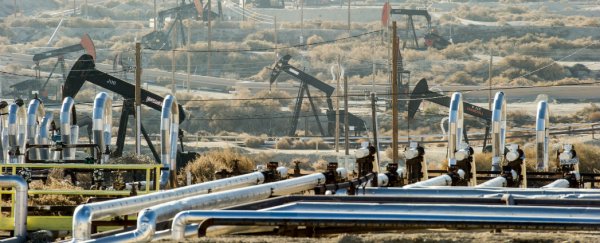In a study that brings into question the safety of fracking near underground drinking water sources, geoscientists in the US have found traces of what they believe to be drilling chemicals in samples of drinking water from three homes in Pennsylvania.
It's the first fully documented case of this occurring, and while experts have called it an "exception" due to some less-than-stellar well construction nearby these homes, researchers are now calling for mining practices to be better managed to mitigate this public risk.
Between 2009 and 2010, five gas well pads were constructed for fracking purposes between 1 and 2.25 km north of a small valley where several homes sourced groundwater for drinking. Two years later, a team of researchers from Pennsylvania State University collected drinking water samples from these homes, and found that three of them were contaminated with 2-Butoxyethanol (2BE) - a common drilling chemical.
"The chemical, which is also commonly used in paint and cosmetics, is known to have caused tumours in rodents, though scientists have not determined if those carcinogenic properties translate to humans," says Nicholas St. Fleur at The New York Times. "The authors said the amount found, which was measured in parts per trillion, was within safety regulations and did not pose a health risk."
The finding has been published in The Proceedings of the National Academy of Sciences.
While mining advocates have slammed the study, saying that tiny amounts like this are also found in perfectly safe household products, and the contamination occurred because the drinking water wells were poorly constructed, the issue is that mining practices shouldn't be impacting the public's water supply, no matter how small that impact might be, or how faulty existing water wells in the area are. "[The study] clearly shows an impact of oil and gas drilling on water quality," Rob Jackson, an environmental scientist from Stanford University in the US, told The New York Times.
Fracking - also known as hydraulic fracturing or HVFV - is a relatively new and widely controversial mining practice that drilling companies hope will give them access to the enormous wealth of natural gas that's been trapped in underground shale formations. It involves drilling a deep hole into the ground and pumping a high-pressure mixture of water, sand, and chemicals down to dislodge the rocks and release the gas into a well. While it can be done both vertically and horizontally into the ground, drilling horizontally into the rock layer has become the more common practice.
Some members of the public have been protesting the technique because of fears that the drilling chemicals could make their way into aquifers, which is what this new study suggests happened, albeit in minuscule amounts. "The organic contaminants - likely derived from drilling or HVHF fluids - were detected using instrumentation not available in most commercial laboratories," the team writes in the paper.
"More such incidents must be analysed and data released publicly so that similar problems can be avoided through use of better management practices."
Earlier this year, it was announced that fracking was banned in New York State, and late last year, the French government announced a nationwide ban, based on on the legal concept of 'precaution'. And when you consider the fact that renewables aren't just better for the environment, they pose less potential health risks, and are now cheaper than fossil fuels, you have to admit, they've got a point.
